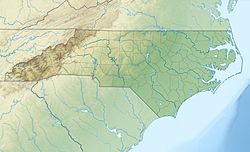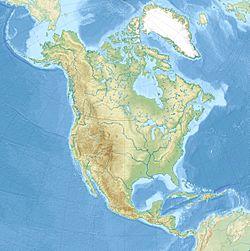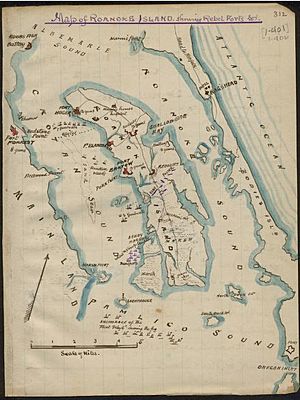Roanoke Island facts for kids
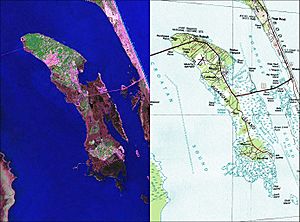
Maps of Roanoke Island taken from the U.S Geological Survey and the U.S Department of the Interior and NASA.
|
|
| Geography | |
|---|---|
| Location | Atlantic Ocean |
| Coordinates | 35°53′20″N 75°39′40″W / 35.889°N 75.661°W |
| Area | 17.95 sq mi (46.5 km2) |
| Administration | |
|
United States
|
|
| State | North Carolina |
| Demographics | |
| Population | 6,724 (2000) |
Roanoke Island (/ˈroʊənoʊk/) is an island in Dare County, bordered by the Outer Banks of North Carolina. It was named after the historical Roanoke, a Carolina Algonquian people who inhabited the area in the 16th century at the time of English colonization.
About 8 mi (13 km) long and 2 mi (3.2 km) wide, the island lies between the mainland and the barrier islands near Nags Head. Albemarle Sound lies on its north, Roanoke Sound on the eastern, Croatan Sound on the west, and Wanchese CDP lies at the southern end. The town of Manteo is located on the northern portion of the island, and is the county seat of Dare County. Fort Raleigh National Historic Site is on the north end of the island. The island has a land area of 17.95 square miles (46.5 km2) and a population of 6,724 as of the 2000 census.
Today U.S. Highway 64, a major highway, connects mainland North Carolina to the Outer Banks, as well as Roanoke Island. The island has recreational and water features, plus historical sites and an outdoor theater that form one of the major tourist attractions of Dare County.
The residents of Roanoke Island are governed by the Dare County Board of Commissioners. They are located within North Carolina's 1st congressional district.
Contents
Etymology
The island was named by English colonists after the Roanoke indigenous people who resided here for generations, at least 800 years prior to the arrival of the English in the New World. The meaning of the word Roanoke is derived from the Powhatan language, which was geographically close to the Roanoke. Roanoke means "white beads made from shells" (or more literally "things rubbed smooth by hand"). White beads were used as ornaments and currency among the Coastal Algonquian peoples of Virginia and North Carolina.
John Smith, an English explorer and one of the first governors of Jamestown, Virginia, recorded the usage of the word Rawrenock in the Algonquin Powhowaten language.
In the context of the quote, Rawranoke refers to the items being traded, not the people. The Roanoke people became known by the English for trading shells prevalent at Roanoke Island and the other barrier islands of the Outer Banks. The Roanoke likely also exported the shells and white beads made from them to other distant cultures across the continent.
History
The First Colony
Roanoke Island was the site of the 16th-century Roanoke Colony, the first English colony in the New World. It was located in what was then called Virginia, named in honor of England's ruling monarch and "Virgin Queen", Elizabeth I. There were two groups of colonists who attempted to establish a colony there, and both groups failed.
The first attempt was headed by Ralph Lane in 1585. Sir Richard Grenville had transported the colonists to Virginia and returned to England for supplies as planned. The colonists were desperately in need of supplies and Grenville's return was delayed. While awaiting his return, the colonists relied heavily upon a local Algonquian tribe. In an effort to gain more food supplies, Lane led an unprovoked attack, killing the tribe's chieftain and effectively cutting off the colony's primary food source. As a result, when Sir Francis Drake put in at Roanoke after attacking the Spanish colony of St. Augustine, the entire population abandoned the colony and returned with Drake to England.
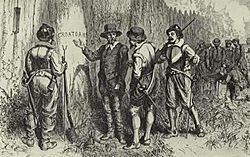
In 1587, the English tried to settle in Roanoke Island again. John White, father of the colonist Eleanor Dare and grandfather to Virginia Dare, the first English child born in the New World, left the colony to return to England for supplies. He expected to return to Roanoke Island within three months. Instead, with England at war with Spain, all ships were confiscated for use of the war efforts. White's return to Roanoke Island was delayed until 1590, by which time all the colonists had disappeared. The settlement was left abandoned. The only clue White found was the word "CROATOAN" carved into a tree. Before leaving the colony three years earlier, White had left instructions that if the colonists left the settlement, they were to carve the name of their destination, with a Maltese cross if they left due to danger.
"CROATOAN" was the name of an island to the south (modern-day Hatteras Island), where a native tribe, friendly to the English was known to live. Colonists might have tried to reach that island. However, foul weather kept White from venturing south to search on Croatoan for the colonists, so he returned to England. White never returned to the New World. Unable to determine exactly what happened, people referred to the abandoned settlement as "The Lost Colony."
Civil War years
During the American Civil War, the Confederacy fortified the island with three forts. The Battle of Roanoke Island (February 7–8, 1862) was an incident in the Union North Carolina Expedition of January to July 1862, when Brigadier General Ambrose E. Burnside landed an amphibious force and took Confederate forts on the island. Afterward, the Union Army retained the three Confederate forts, renaming them for the Union generals who had commanded the winning forces: Huger became Fort Reno; Blanchard became Fort Parke; and Bartow became Fort Foster. After the Confederacy lost the forts, the Confederate Secretary of War, Judah P. Benjamin, resigned. Roanoke Island was occupied by Union forces for the duration of the war, through 1865.
Slaves from the island and the mainland of North Carolina fled to the Union-occupied area with hopes of gaining freedom. By 1863, numerous former slaves were living on the fringe of the Union camp. The Union Army had classified the former slaves as "contrabands," and determined not to return them to Confederate slaveholders. The freedmen founded churches in their settlement and started what was likely the first free school for blacks in North Carolina.
Horace James, an experienced Congregational chaplain, was appointed by the US Army in 1863 as "Superintendent for Negro Affairs in the North Carolina District." He was responsible for the Trent River contraband camp at New Bern, North Carolina, where he was based. He also was ordered to create a self-sustaining colony at Roanoke Island and thought it had the potential to be a model for a new society in which African Americans would have freedom. In addition to serving the original residents and recent migrants, the Roanoke Island Freedmen's Colony was to be a refuge for the families of freedmen who enlisted in the Union Army as United States Colored Troops. By 1864, there were more than 2200 freedmen on the island.
Under James, the freedmen were allocated plots of land per household, and paid for work for the Army. He established a sawmill on the island and a fisheries, and began to market the many highly skilled crafts by freed people artisans. James believed the colony was a critical social experiment in free labor and a potential model for resettling freedmen on their own lands. Northern missionary teachers, mostly women from New England, journeyed to the island to teach reading and writing to both children and adults, who were eager for education. A total of 27 teachers served the island, with a core group of about six.
The colony and Union troops had difficulty with overcrowding, poor sanitation, limited food and disease in its last year. The freedmen had found that the soil was too poor to support subsistence farming for so many people. In late 1865 after the end of the war, the Army dismantled the forts on Roanoke. In 1865, President Andrew Johnson issued an "Amnesty Proclamation," ordering the return of property by the Union Army to former Confederate landowners. Most of the 100 contraband camps in the South were on former Confederate land. At Roanoke Island, the freedmen had never been given title to their plots, and the land was reverted to previous European-American owners.
Most freedmen chose to leave the island, and the Army arranged for their transportation to towns and counties on the mainland, where they looked for work. By 1867 the Army had abandoned the colony. In 1870 only 300 freedmen were living on the island. Some of their descendants still live there.
Legacy
- In 2001, Dare County erected a marble monument to the Freedmen's Colony at the Fort Raleigh Historic Site.
- It is listed as a site within the National Underground Railroad to Freedom Network of the National Park Service.
- Home and burial place of Andy Griffith
The "Mother Vine"
Possibly the oldest cultivated grapevine in the world is the 400-year-old scuppernong "Mother Vine" growing on Roanoke Island. The scuppernong is the state fruit of North Carolina.
Education
The island is in Dare County Schools. Residents are zoned to Manteo Elementary School, Manteo Middle School, and Manteo High School.
Museums on Roanoke Island
- Fort Raleigh National Historic Site
- National Wildlife Refuges Visitor Center
- North Carolina Maritime Museum on Roanoke Island
- Roanoke Island Aquarium
- Roanoke Island Festival Park
- Roanoke Marshes Lighthouse


